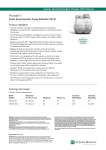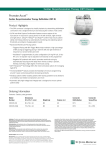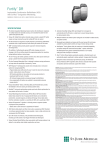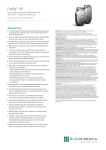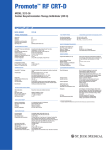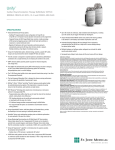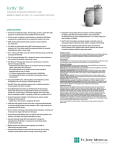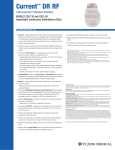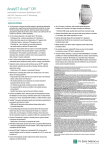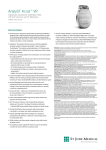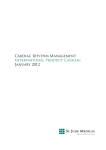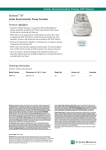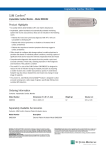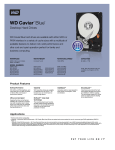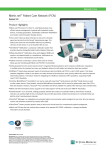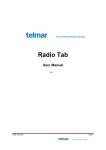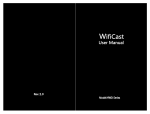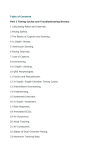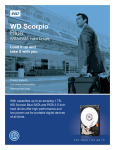Download Fortify™ DR
Transcript
Implantable Cardioverter Defibrillator (ICD) Devices Fortify™ DR Dual-Chamber Implantable Cardioverter Defibrillator (ICD) Product Highlights Q ShockGuard™ technology with DecisionTx™ programming, designed to reduce inappropriate therapy and minimise the need for programming adjustments at implant Q Unique 40 J delivered energy safety shock option can provide a greater DFT safety margin Q The DF4 connector is designed to simplify implants by streamlining defibrillation connections into a single terminal pin and reducing the number of set screws Merlin@home™ Transmitter Compatible ™ Q QHR * chemistry battery provides greater capacity for enhanced longevity and stable charge times Q Antitachycardia pacing (ATP) while charging and prior to charging in the VF zone further extends the programming options for terminating tachyarrhythmias without a high-voltage shock Q The low frequency attenuation filter is designed to enhance sensing performance and may reduce the possibility of oversensing T waves Q DeFT Response™ technology offers the most noninvasive options for managing high DFTs Q Vibratory patient notifier enables patients with hearing problems to be alerted to a low battery, lead-related complications and more Q The SenseAbility™ feature provides the flexibility to fine-tune programming around T-wave oversensing without decreasing sensitivity Q Ventricular Intrinsic Preference (VIP™) algorithm automatically searches for intrinsic conduction Ordering Information Contents: Cardiac pulse generator Model Number Dimensions (H x W x T, mm) Weight (g) Volume (cc) Connector Defibrillation Connector Sense/Pace CD2233-40 74 x 40 x 14 76 35 DF1 IS-1 CD2233-40Q 71 x 40 x 14 75 35 DF4 IS-1; DF4 Indications: The devices are intended to provide ventricular antitachycardia pacing and ventricular defibrillation for automated treatment of life-threatening ventricular arrhythmias. Contraindications: Contraindications for use of the pulse generator system include ventricular tachyarrhythmias resulting from transient or correctable factors such as drug toxicity, electrolyte imbalance, or acute myocardial infarction. Adverse Events: Implantation of the pulse generator system, like that of any other device, involves risks, some possibly life-threatening. These include but are not limited to the following: acute hemorrhage/bleeding, air emboli, arrhythmia acceleration, cardiac or venous perforation, cardiogenic shock, cyst formation, erosion, exacerbation of heart failure, extrusion, fibrotic tissue growth, fluid accumulation, hematoma formation, Customer Support: 46-8-474-4756 Brief Summary: Prior to using these devices, please review the Instructions for Use for a complete listing of indications, contraindications, warnings, precautions, potential adverse events and directions for use. Devices depicted may not be available in all countries. Check with your St. Jude Medical representative for product availability in your country. Unless otherwise noted, ™ indicates that the name is a trademark of, or licensed to, St. Jude Medical or one of its subsidiaries. ST. JUDE MEDICAL, the nine-squares symbol and MORE CONTROL. LESS RISK. are registered and unregistered trademarks and service marks of St. Jude Medical, Inc. and its related companies. ©2011 St. Jude Medical, Inc. All rights reserved. histotoxic reactions, infection, keloid formation, myocardial irritability, nerve damage, pneumothorax, thromboemboli, venous occlusion. Other possible adverse effects include mortality due to: component failure, device-programmer communication failure, lead abrasion, lead dislodgment or poor lead placement, lead fracture, inability to defibrillate, inhibited therapy for a ventricular tachycardia, interruption of function due to electrical or magnetic interference, shunting of energy from defibrillation paddles, system failure due to ionising radiation. Other possible adverse effects include mortality due to inappropriate delivery of therapy caused by: multiple counting of cardiac events including T waves, P waves, or supplemental pacemaker stimuli. Among the psychological effects of device implantation are imagined pulsing, dependency, fear of inappropriate pulsing, and fear of losing pulse capability. Refer to the User’s Manual for detailed indications, contraindications, warnings, precautions and potential adverse events. Implantable Cardioverter Defibrillator (ICD) Devices Fortify™ DR Dual-Chamber Implantable Cardioverter Defibrillator (ICD) Product Specifications PHYSICAL SPECIFICATIONS Models Telemetry Delivered/Stored Energy (J) Volume (cc) Weight (g) Size (mm) Defibrillation Lead Connections Sense/Pace Lead Connections High-Voltage Can Post-Therapy Pacing (Independently programmable from Bradycardia and ATP) CD2233-40 RF 40/45 35 76 74 x 40 x 14 DF1 IS-1 Electrically active titanium can PARAMETER AF Managemen t SETTINGS AF Suppression™ Pacing No. of Overdrive Pacing Cycles Maximum AF Suppression Rate On; Off 15-40 in steps of 5 80-150 min-1 CD2233-40Q RF 40/45 35 75 71 x 40 x 14 DF4 DF4 Electrically active titanium can Decay Delay Ventricular Sense Refractory (ms) Detection Zones SVT Discriminators Reconfirmation Automatic Sensitivity Control adjustment for atrial and ventricular events On; Off (Post-Sensed; Atrial) 50; 62,5; 75; 100%; (Post-Paced; Atrial) 0,2-3,0 mV; (Post-Sensed; Ventricular) 50; 62,5; 75; 100%; (Post-Paced; Ventricular) Auto; 0,2-3,0 mV (Post-Sense/Post-Pace; Atrial/Ventricular) 0-220 125; 157 VT-1; VT-2; VF AV Rate Branch; Sudden Onset; Interval Stability; Morphology Discrimination (MD) with Manual or Automatic Template Update Continuous sensing during charging Antitachycardia Pacing Therapy ATP Configurations ATP in VF Zone ATP Upper Rate Cutoff Burst Cycle Length Min. Burst Cycle Length (ms) Number of Bursts Number of Stimuli Add Stimuli per Burst ATP Pulse Amplitude (V) ATP Pulse Width (ms) Off; AAI; VVI; DDI; DDD 30-100 in increments of 5 Off; 0,5; 1; 2,5; 5; 7,5; or 10 Device Testing/Induction Methods DC Fibber™ Pulse Duration (sec) Burst Fibber Cycle Length (ms) Noninvasive Programmed Stimulation (NIPS) 0,5-5,0 20-100 2-25 stimuli with up to three extrastimuli Patient Notifiers Programmable Notifiers (On; Off) Sensing/Detection SenseAbility™ Technology Low Frequency Attenuation Threshold Start Post-Shock Pacing Mode Post-Shock Base Rate (min-1) Post-Shock Pacing Duration (min) Ramp; Burst; Scan; 1 or 2 schemes per VT zone ATP While Charging; ATP Prior to Charging; Off 150 - 300 bpm Adaptive; Readaptive or Fixed 150-400 in increments of 5 1-15 2-20 On; Off 7,5 Independent from Bradycardia and Post-Therapy Pacing 1,0 or 1,5 Independently programmable from Bradycardia and Post-Therapy Pacing Device at ERI; Charge Time Limit Reached; Possible HV Circuit Damage; Atrial Lead Impedance Out of Range; Ventricular Lead Impedance Out of Range; High-Voltage Lead Impedance Out of Range; AT/AF Burden; V Rate During AT/AF; % V pacing; CorVue Congestion Trigger Device Parameter Reset On Entry into Backup VVI Mode On Vibration Duration (sec) 2; 4; 6; 8; 10; 12; 14; 16 Number of Vibrations per Notification 2 Number of Notifications 1-16 Time Between Notifications (hours) 10; 22 Electrograms and Diagnostics Stored Electrograms Up to 45 minutes including up to one minute programmable pre-trigger data per VT/VF diagnosis/detection electrograms; triggers include diagnosis; therapy; atrial episode; PMT termination; PC shock delivery; noise reversion; magnet reversion; and morphology template verification Therapy Summary Diagram of therapies delivered Episodes Summary Directory listing of up to 60 episodes with access to more details including stored electrograms Lifetime Diagnostics History of bradycardia events and device-initiated charging AT/AF Burden Trend Trend data and counts Ventricular HV Lead Impedance Trend Multi-Vector Trend Data Histograms Event Histogram; AV Interval Histogram; Mode Switch Duration Histogram; Peak Filtered Rate Histogram; Atrial Heart Rate Histogram; Ventricular Heart Rate Histogram; AT/AF Burden; Exercise and Activity Trending; V Rates during AMS PMT Data Information regarding PMT detections Real-Time Measurements (RTM) Pacing lead impedances; high-voltage lead impedances; unloaded battery voltage; and signal amplitudes CorVue™ Congestion Monitoring On; Off CorVue Congestion Trigger 8-18 days High-Voltage Therapy High-Voltage Output Mode Waveform RV Polarity Electrode Configuration Fixed Pulse Width; Fixed Tilt Biphasic; Monophasic Cathode (-); Anode (+) RV to Can; RV to SVC/Can Bradycardia Pacing DDD(R); DDI(R); VVI(R); AAI(R); Pacer Off Off; DDD; DDI; VVI; AAI; AAT; DOO; VOO; AOO (Post-Sense/Post-Pace; Atrial/Ventricular) 0-220 Off; Base Rate (min-1); Rest Rate (min-1); Maximum Tracking Rate (min-1); Maximum Sensor Rate (min-1); Paced AV Delay (ms); Sensed AV Delay (ms); Rate Responsive AV Delay; Pulse Amplitude (Atrial; RV) (V); Pulse Width (Atrial and RV) (ms); Hysteresis Rate (min-1); Rate Hysteresis with Search ™ QuickOpt Timing Cycle Optimisation Sensed/Paced AV delay Auto Mode Switch (AMS) Off; DDI(R); VVI(R) Atrial Tachycardia 110-300 Detection Rate (min-1) AMS Base Rate (min-1) 40; 45;...135 Auto PMT Detection/Termination A Pace on PMT; Off; Passive Rate Responsive PVARP/VREF Off; Low; Medium; High Ventricular Intrinsic Preference (VIP™) Off; 50-200 (50-150 in increments of 25; 160-200 in increments of 10) ™ Ventricular AutoCapture On; Off Pacing System ™ ACap Confirm On; Monitor; Off (GMCRM779EN) Permanent Modes Temporary Modes Rate-Adaptive Sensor Programmable Rate and Delay Parameters Customer Support: 46-8-474-4756 Brief Summary: Prior to using these devices, please review the Instructions for Use for a complete listing of indications, contraindications, warnings, precautions, potential adverse events and directions for use. Devices depicted may not be available in all countries. Check with your St. Jude Medical representative for product availability in your country. Unless otherwise noted, ™ indicates that the name is a trademark of, or licensed to, St. Jude Medical or one of its subsidiaries. ST. JUDE MEDICAL, the nine-squares symbol and MORE CONTROL. LESS RISK. are registered and unregistered trademarks and service marks of St. Jude Medical, Inc. and its related companies. ©2011 St. Jude Medical, Inc. All rights reserved. Item GMCRM779EN *QHR is a trademark of Greatbatch, LTD.



